Facilities (Learning Spaces)
Sports Facilities: Focusing On Elevating the Fan Experience
- By Sarat Pratapchandran
- 09/01/18
Sports facilities in schools and universities are incorporating new design trends to drive more fans from their homes to the stadium. “Sports facility design today is about elevating the fan experience and affiliation to their team, and responding to new behaviors of spectators,” said Don Barnum, AIA, Global Sports leader at DLR Group.
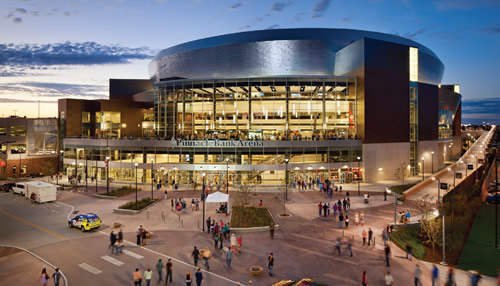
PHOTO © LAWRENCE ANDERSON PHOTOGRAPHY, COURTESY OF DLR GROUP
Data from the National Federation of State High School Associations show that 8 million high school students actively participated in athletics last year, with Texas ranking number one in terms of number of students participating in athletics. The state is also home to a $70-million football stadium at Katy ISD, the most expensive high school stadium in the U.S.
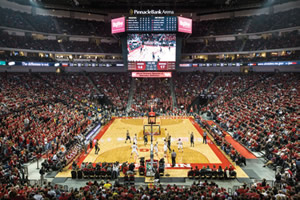
PHOTO © LAWRENCE ANDERSON PHOTOGRAPHY, COURTESY OF DLR GROUP
According to its designers, HKS, the focus was on three key areas—venue performance, fan experience and community identity. Venue performance included sports lighting levels, sightlines, sound and video systems, turf systems, operational efficiencies, and maintainability. The Fan experience strived to deliver a unique sense of enjoyment and delight relating to ease of use, services provided, comfort, accommodation, and wellbeing. And, community identity created a “sense of place” that valued the spirit of Katy ISD schools and families.
With rapid advances in technology, sports facility designers feel that “In stadium venues, technology is reshaping fan experience— be it how they order concessions from their phone, check on fantasy sports during game action, or connect with other fans,” said Colleen McKenna, director of Cannon-Design’s Sports + Recreation Practice.
Meanwhile, an inclusive sports experience must take into account the needs of diverse groups. Facilities are being designed for both genders, and “this often focuses around bathroom and locker room spaces, but can actually impact how cardio and weight training spaces are organized, outdoor recreation offerings, technology, and more, and it’s a topic on the mind of every campus recreation leader,” said McKenna.
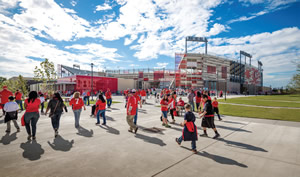
PHOTO © SLYWORKS PHOTOGRAPHY, COURTESY OF DLR GROUP
In the seats. An inclusive sports experience must take into account the needs of diverse groups. Facilities are being designed for both genders, and this often focuses around bathroom and locker room spaces, but can actually impact how cardio and weight training spaces are organized, outdoor recreation offerings, technology, and more, and it’s a topic on the mind of every campus recreation leader. Safety is top of the mind for sports facility planners and designers and they often work closely with security teams right from the design phase.
However, drawing more attendance is key and designers are adding social spaces “to allow the venue to promote greater interaction between guests and their families and friends.” According to McKenna, English Field at Union Park—Virginia Tech’s new baseball stadium incorporates grass terraces where “fans can relax, socialize, play catch, eat a picnic lunch—they really help to expand the ballpark experience and welcome new types of fans who might not be interested in taking a seat and watching every pitch and swing.”
Safety is top of the mind for sports facility planners and designers and they often work closely with security teams right from the design phase. According to Barnum, “properly designed entryways and access points to stadiums can add to the convenience of the fan experience and overall safety of patrons entering and exiting the venue. During early phases, the design team should work closely with representatives from the school, venue operators, and solicit the expertise of public safety officers and homeland security experts. Engaging a collaborative group of experts can accomplish several customer service initiatives while ensuring the safety of all spectators.”
In newly designed sports facilities, vehicles are kept at a safe distance from the building by installing perimeter barriers. “The best designs are those that are seamlessly integrated into the planning, such as landscaping and gated controls of the facility with materials that look like they belong to the design rather than plain fencing,” said Barnum. He cites the example of the Coliseum in Los Angeles that has created a double fence perimeter with a “no man’s land” between that prevents anything from being handed through or thrown over the fence.
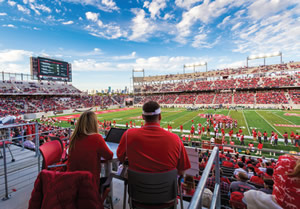
PHOTO © SLYWORKS PHOTOGRAPHY, COURTESY OF DLR GROUP
And, every venue is competing for fans discretionary dollars. “Every moment of a fan’s engagement with the event, from leaving the driveway until they return home, is a potential touch point for the event to influence,” Barnum said. This means planners and designers have to improve the fan experience including their “access to the venue, parking, type of seating, food and beverage, social interaction with their peers, merchandise, in game entertainment, sight and sound; and, oh yes, there is a game going on too.”
Today’s sports fans, whether it’s at the high school level or the collegiate level want many options. They want “affordable, yet premium experiences that take them beyond their designated seat; they want closer proximity to the field and athletes.” Millennials and younger fans want to mingle during a game and broadcast their experience to their social network. Firms like DLR Group are constantly monitoring fan psychology and their expectations at live events and translating their needs while designing new sports facilities.
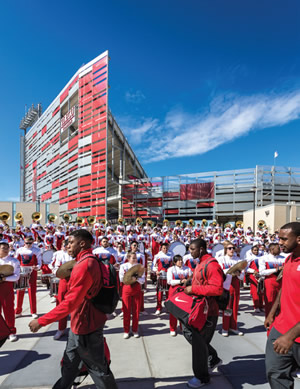
PHOTO © SLYWORKS PHOTOGRAPHY, COURTESY OF DLR GROUP
Families want child-friendly areas and millennials crave social zones to connect with their peers during a game. This has led many stadiums to have group or picnic seating to accommodate fans of all ages and amusement park amenities to keep families entertained throughout the duration of a game.
“One of the most significant trends we’ve noticed is that fans are more excited to share their own experiences in a club space with friends or at an iconic statue in a fan plaza rather than an exciting dunk or touchdown by their favorite player. Armed with this knowledge, our stadium designs feature various gathering spots and memorable attractions people seek out to broadcast to the world,” Barnum said.
The results are higher event attendance and better, more memorable fan experiences. For instance, Nebraska’s basketball attendance has increased 54 percent since the opening of the Pinnacle Bank Arena. And, when University of Maryland Baltimore County (UMBC) recently opened a new Campus Event Center for their basketball and volleyball programs they have expanded attendance for sporting events using the space to host ticketed events like concerts, comedians and performances for students, staff and the nearby community.
Sports facility designs in community centers are also trying to draw more people into a multi-use facility that integrates athletics, wellness and recreation. An example is the city of Maryland Heights that recently opened a new community center outside St. Louis for community recreation or services. According to McKenna, in its first eight months of operation, the center welcomed 84,000 visits, had attendance of over 38,000 for its rental facilities and has seen 5,000 seniors attend programs.
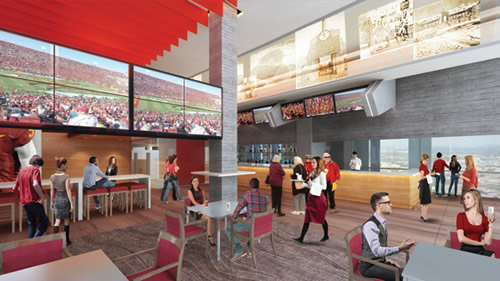
©DLR Group
Many institutions are modeling bold new ideas to integrate wellness, disease prevention, and recreation in singular spaces. They see data that indicates more than 60 percent of students don’t think they’re in “very good shape” and that numerous others are struggling with loneliness, depression, or other serious challenges and recognize a need to offer more holistic solutions.
“There is no one-size-fits-all solution for integration, but colleges and universities are finding new ways to blend academic, counseling, nutrition, recreation, athletics, meditation, prayer space, and more in to a single building,” said McKenna.
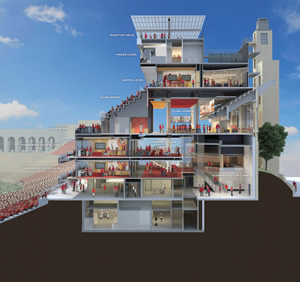
©DLR Group
There is also an emphasis on sustainable design elements and systems. “Renewable energy systems (solar and wind) are being incorporated into building designs, not only as eco-friendly aspects, but also as aesthetic and sponsorship opportunities,” Barnum said. DLR Group has incorporated solar and/or wind renewable energy installations at seven major professional sports venues, including the Washington Redskins, New England Patriots, and San Francisco 49ers. These systems provide a portion of game-day power and on non-game days are putting energy back in the grid, reducing the carbon footprint and helping the facilities bottom line. Many stadiums have also embraced waste reduction initiatives, some with goals as great as 100 percent.
With a strong economy, schools are using multiple resources to finance these facilities. Public funding could include municipal bonds, tax levies and other resources and some also turn to donor support to fund their facilities. For instance, the Katy ISD school board sold its naming rights to Academy Sports + Outdoors for a 10-year period at $2.5 million.
This article originally appeared in the School Planning & Management September 2018 issue of Spaces4Learning.